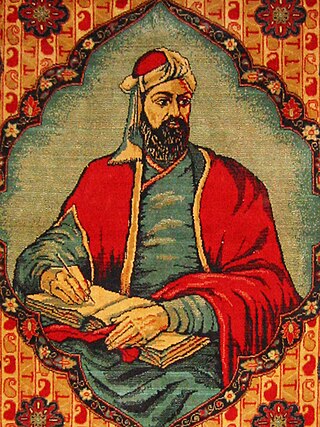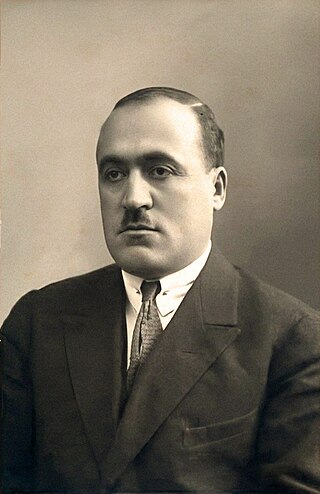Nizami (Persian: نظامی) may refer to:
Nizami (Persian: نظامی) may refer to:
Articles related to the Azerbaijan Republic include:

Nizami Ganjavi, Nizami Ganje'i, Nizami, or Nezāmi, whose formal name was Jamal ad-Dīn Abū Muḥammad Ilyās ibn-Yūsuf ibn-Zakkī, was a 12th-century Muslim poet. Nezāmi is considered the greatest romantic epic poet in Persian literature, who brought a colloquial and realistic style to the Persian epic. His heritage is widely appreciated and shared by Afghanistan, Republic of Azerbaijan, Iran, the Kurdistan region and Tajikistan.
Khamsa may refer to:
Khosrow may refer to:

Ganja is Azerbaijan's third largest city, with a population of around 335,600. The city has been a historic and cultural center throughout most of its existence. It was the capital of the Ganja Khanate until 1804; after Qajar Iran ceded it to the Russian Empire following the Treaty of Gulistan in 1813, it became part of the administrative divisions of the Georgia Governorate, Georgia-Imeretia Governorate, Tiflis Governorate, and Elizavetpol Governorate. Following the dissolution of the Russian Empire and the Transcaucasian Democratic Federative Republic, it became a part of the Azerbaijan Democratic Republic, followed by Azerbaijan SSR, and, since 1991, the Republic of Azerbaijan.

Goranboy District is one of the 66 districts of Azerbaijan. It is located in the west of the country and belongs to the Ganja-Dashkasan Economic Region. The district borders the districts of Kalbajar, Tartar, Yevlakh, Samukh, and Goygol. Its capital and largest city is Goranboy. As of 2020, the district had a population of 105,000.

Khosrow and Shirin is the title of a famous tragic romance by the Persian poet Nizami Ganjavi (1141–1209), who also wrote Layla and Majnun. It tells a highly elaborated fictional version of the story of the love of the Sasanian king Khosrow II for the Armenian princess Shirin, who becomes queen of Persia. The essential narrative is a love story of Persian origin which was already well known from the great epico-historical poem the Shahnameh and other Persian writers and popular tales, and other works have the same title.

Mammad Said Ordubadi was Azerbaijani writer, poet, playwright and journalist.

Shirvanshah, was the title of the rulers of Shirvan from 861 to 1538. The first ruling line were the Yazidids, an originally Arab and later Persianized dynasty, who became known as the Kasranids. The second ruling line were the Darbandi, distant relatives of the Yazidids/Kasranids.
Nizami is a village and municipality in the Sabirabad Rayon of Azerbaijan. In 2004, the village was renamed in honor of the poet, Nizami. It has a population of 2,852.

Sabirabad is a city in and the capital of the Sabirabad District of Azerbaijan. The city was renamed in honor of the poet Mirza Alakbar Sabir. Sabirabad is the administrative center of Sabirabad District of the Republic of Azerbaijan. In 1935, the district received the status of subordinate city. Sabirabad is located on the right bank of the Kura River. In the vicinity of the city called Sugovushan, the Araz River is merged with the Kur River.
Nizami Rayon is a municipal district of the city of Baku, the capital of Azerbaijan. Its population is 201,239 and it includes the municipality of Keşlə. Of these, 25,626 lives in Keşlə municipality. The raion's area is 19.6 km².

The National museum of Azerbaijan literature named after Nizami Ganjavi is a museum in Baku, established in 1939. It is located near the entrance of Icheri Sheher, not far from the Fountains Square. The museum is considered one of the greatest and richest treasuries of Azerbaijani culture.
Nizam al-Din, spelled variously Nizamuddin or Nizamüddin or etc. may refer to:
Campaign on granting Nizami the status of the national poet of Azerbaijan – is a politically and ideologically motivated distortion of the historical record of the national-cultural origin of one of the classics of Persian poetry, Nizami Ganjavi, which began in the USSR in the late 1930s and was arranged to coincide with the celebration of the 800th anniversary of the poet. The campaign was crowned with jubilee celebrations in 1947 but its effects continue up to this day: on one hand this process was beneficial for many cultures of the multi-cultural Soviet Union and for the Azerbaijani culture in the first place; on the other hand this brought to an extreme politicization of the question on Nizami's cultural-national identity in the USSR and in modern Azerbaijan.
Jawad is a village in Madhya Pradesh, India.
The Kasranids were a branch of the Shirvanshahs, who ruled the Shirvan region for 387 years. The word "Kasra" was derived from legendary king Kai Khosrow of Iran, reflecting a shift in naming tradition from Arabic to Persian and it was part of an effort to break with their Arabic roots by claiming to be successors of the Sassanids and the Kayanian dynasty.

Ramiz Abbasli is an Azerbaijani author, translator of fiction.
"Layla and Majnun" is the third poem of the classic of Nizami Ganjavi. This poem is included in "Khamsa" and was written in 1188 in Persian. It is based on the story of the ancient Arabic legend "Layla and Majnun" about the unhappy love of the young man Qays, nicknamed "Majnun", towards beautiful Layla. The poem is dedicated to Shirvanshah Ahsitan I, and was written on his order. There are 4600 stanzas in the poem. This poem is considered as the first literary processing of the legend.

Makhzan ol-Asrar or Makhzan al-Asrar is the title of a famous Mathnawi by the Persian poet Nizami Ganjavi (1141–1209). Makhzan ol-Asrar is the first poem collection in the main and best known work of Nizami Ganjavi called Khamsa of Nizami and one of the prominent examples of didactic literature. This Mathnawi has about 2,250 Persian distichs and it was completed at the age of forty of Nizami Ganjavi and since then it has always been considered one of the most important poetic and written works in Persian literature.